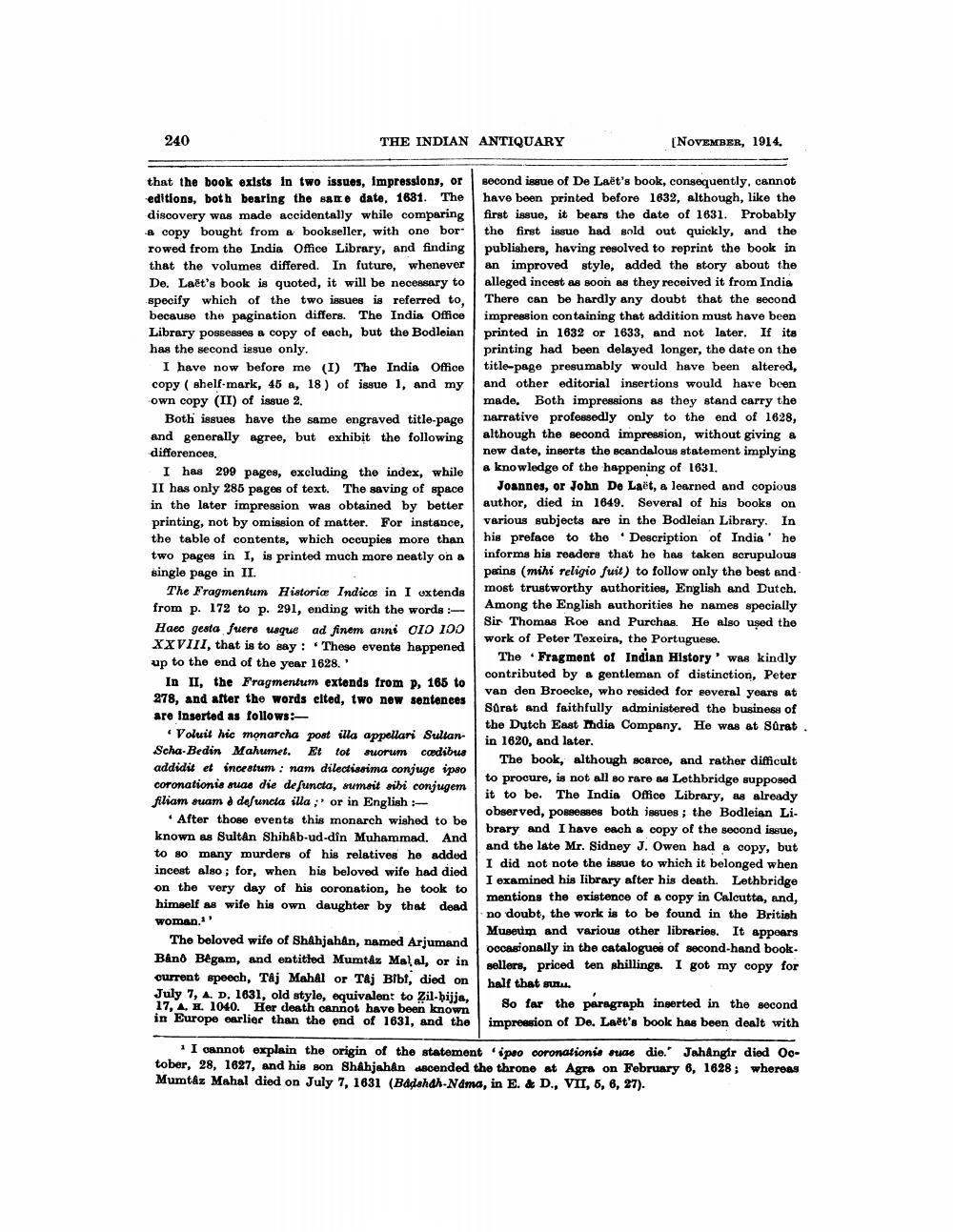________________
240
THE INDIAN ANTIQUARY
(NOVEMBER, 1914.
that the book exists in two issues, Impressions, or editions, both bearing the same date, 1881. The discovery was made accidentally while comparing A copy bought from & bookseller, with one bor rowed from the India Office Library, and finding that the volumes differed. In future, whenever De. Laët's book is quoted, it will be necessary to specify which of the two issues is referred to, because the pagination differs. The India Office Library possesses a copy of each, but the Bodleian has the second issue only.
I have now before me (I) The India Office copy (shelf-mark, 45 a, 18 ) of issue 1, and my own copy (II) of issue 2.
Both issues have the same engraved title-page and generally agree, but exhibit the following differences.
I has 299 pages, excluding the index, while II has only 285 pages of text. The saving of space in the later impression was obtained by better printing, not by omission of matter. For instance, the table of contents, which occupies more than two pages in I, is printed much more neatly on a single page in II.
The Fragmentum Historiæ Indice in I extends from p. 172 to p. 291, ending with the words :Haec gesta fuere usque ad finem anni 010 100 XXVIII, that is to say: These events happened up to the end of the year 1628.'
In II, the Fragmentum extends from P, 165 to 278, and after the words cited, two now sentences are inserted as follows:
Voluit hic monarcha post illa appellari SultanScha-Bedin Mahumet. Et tot suorum cædibus addidit et incestum : nam dilectissima conjuge ipso coronationis mude die de functa, sumait sibi conjugem filiam suam d defuncia illa ;' or in English
After those events this monarch wished to be known as Sultan Shihab-ud-din Muhammad. And to so many murders of his relatives he added incest also; for, when his beloved wife had died on the very day of his coronation, he took to himself as wife his own daughter by that dead woman.'
The beloved wife of Shahjahan, named Arjumand Band Begam, and entitled Mumtaz Malal, or in current speech, Taj Mahal or Taj Bibt, died on July 7, A. D. 1631, old style, equivalent to Zil-bijja, 17, 4. 1. 1040. Her death cannot have been known in Europe earlier than the end of 1631, and the
second issue of De Laët's book, consequently, cannot have been printed before 1632, although, like the first issue, it bears the date of 1631. Probably the first issue had sold out quickly, and the publishers, having resolved to reprint the book in an improved style, added the story about the alleged incest as soon as they received it from India There can be hardly any doubt that the second impression containing that addition must have been printed in 1832 or 1633, and not later. If its printing had been delayed longer, the date on the title-page presumably would have been altered, and other editorial insertions would have been made. Both impressions as they stand carry the narrative professedly only to the end of 1628, although the second impression, without giving a new date, inserts the scandalous statement implying a knowledge of the happening of 1631.
Joannes, or John De Laët, a learned and copious author, died in 1649. Several of his books on various subjects are in the Bodleian Library. In his preface to the Description of India' he informs his readers that he has taken scrupulous pains (mihi religio fuit) to follow only the best and most trustworthy authorities, English and Dutch. Among the English authorities he names specially Sir Thomas Roe and Purchas. He also used the work of Peter Texeira, the Portuguese.
The Fragment of Indian History' was kindly contributed by a gentleman of distinction, Peter van den Broecke, who resided for several years at Sarat and faithfully administered the business of the Dutch East Mdia Company. He was at Sorat. in 1620, and later.
The book, although scarce, and rather difficult to procure, is not all so rare es Lethbridge supposed it to be. The India Office Library, as already observed, possesses both issues; the Bodleian Li. brary and I have each & copy of the second issue, and the late Mr. Sidney J. Owen had a copy, but I did not note the issue to which it belonged when I examined his library after his death. Lethbridge mentions the existence of a copy in Calcutta, and, no doubt, the work is to be found in the British Museum and various other libraries. It appears occasionally in the catalogues of second-hand book. sellers, priced ten shillings. I got my copy for half that sinu.
So far the paragraph inserted in the second impression of De. Laët's book has been dealt with
I cannot explain the origin of the statement ipeo coronationis suae die Jahangir died Ootober, 28, 1627, and his son Shahjahan ascended the throne at Agra on February 6, 1028; whereas Mumtaz Mahal died on July 7, 1631 (Badshah-Nama, in E. & D., VII, 6, 6, 27).




